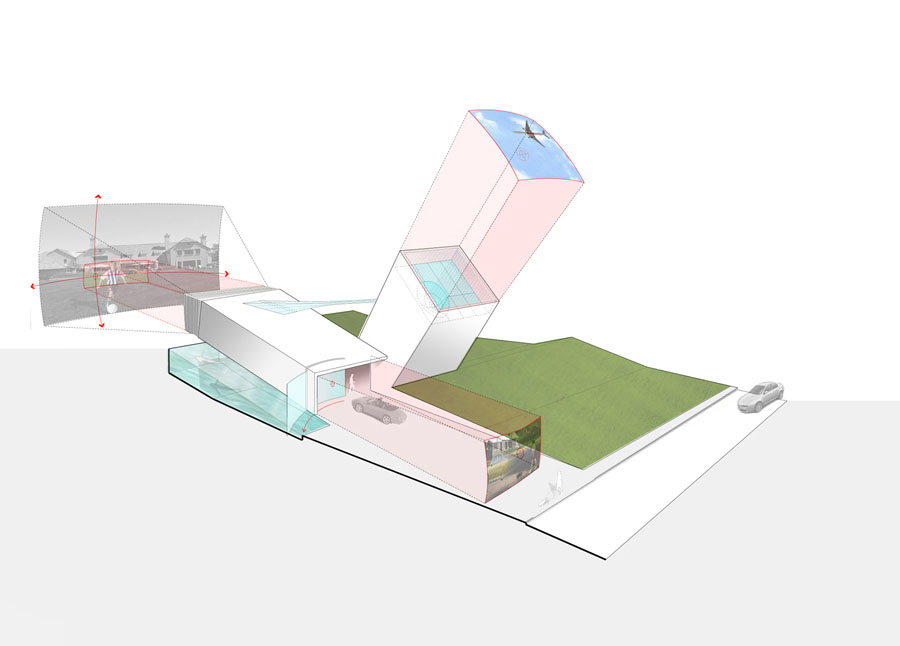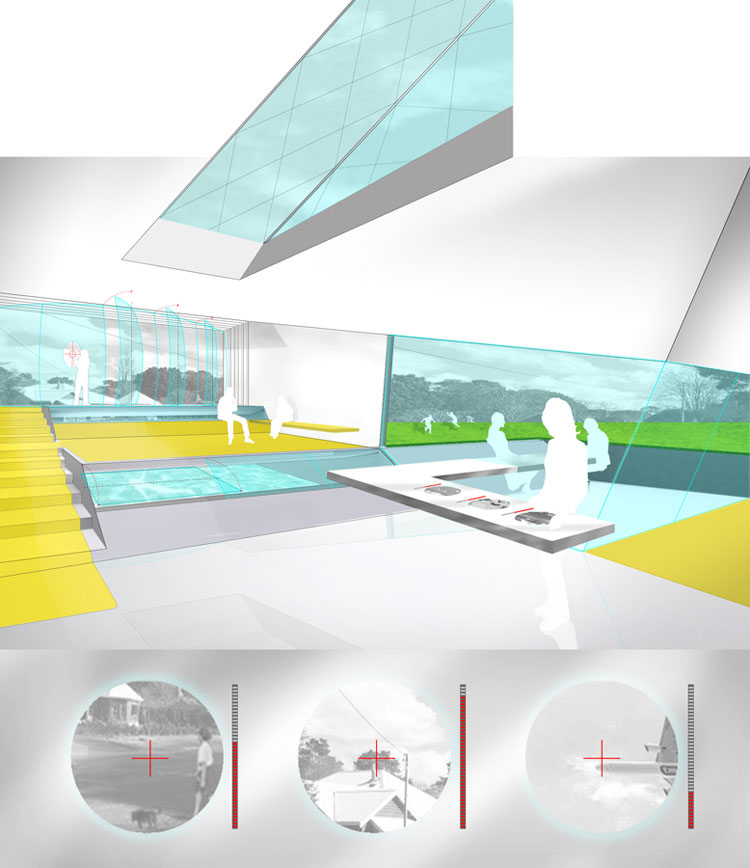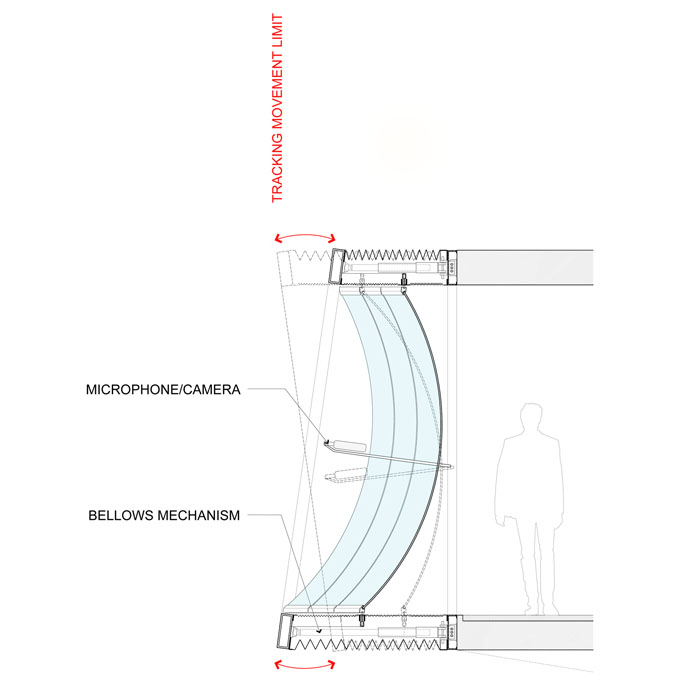 [Image: The Mix House, exterior view].
[Image: The Mix House, exterior view].
This awesome new project by Joel Sanders Architect, Karen Van Lengen/KVL, and Ben Rubin/Ear Studio takes a step beyond “the modernist notion of visual transparency” (i.e. large windows and glass houses) by adding “aural transparency” – acoustic openness.
 [Image: Mix House, exterior].
[Image: Mix House, exterior].
It’s called the Mix House:
Situated on a generic suburban plot, the dwelling is composed of two sound-gathering volumes outfitted with three audiovisual windows. The curved profile of each of these sonic windows is composed of two elements: a louvered glass window wall that regulates the sound of the air-borne ambient environment, and a parabolic dish that electronically targets domestic sounds and transmits them to an interior audio system controlled from the kitchen island. From this sound command center of the house, occupants are free to design original domestic soundscapes by mixing media sponsored sounds with the ambient noises of the neighborhood.
These “sonic windows” – or parabolic ornaments – amplify the audio setting of the house, thus making location, I’d think, several orders of magnitude more important than with many others works of architecture.
In fact, should a house like this really be constructed in the suburbs? Instead of deep in the woods somewhere, or even on top of a glacier…? Crystalline pressures of melting ice three thousand feet below you suddenly break, sending cascades of sound shivering upward through the home’s foundations. Some days it’s impossible to get out of bed, hypnotized by unearthly noises…
 [Image: Mix House, interior].
[Image: Mix House, interior].
In any case, the “den/bedroom wing is oriented vertically to capture audio-visual views of the sky,” we read, and “the front window wall doubles as a sliding glass door that allows the occupant to hear the sounds of the streetscape.”
Further: “Located above the bed, the skylight captures sky-borne sounds, as well as signals transmitted through TV and Internet connections.”
It’s architecture as the cure for – or cause of? – schizophrenia.
 [Image: Mix House, exterior section and plan].
[Image: Mix House, exterior section and plan].
The artistic possibilities here are extraordinary.
One wonders, for instance, if several of these houses could be constructed in the same neighborhood, on the same street – with each one then hooked up to public broadcasting equipment and loudspeakers. Pirate radio. Cul-de-sac FM.
The houses thus play sounds for each other, like instruments, orchestrally contributing to the neighborhood’s sonic environment – becoming part of one another’s “audio-visual views.”
Each house – already an outside-in acoustic snapshot of the environment in real-time – turns sound around to offer a corresponding inside-out anthem for the streets and passers by: the clinking forks and knives of a private dining room get broadcast onto the street. A kind of architecturally outside-inside-out soundtrack for the local world.
 [Image: Mix House, amplifying window technical detail].
[Image: Mix House, amplifying window technical detail].
Drunk homeowners mix burps with airplane roars, standing at an audio booth in the kitchen.
Someone plays layered tape-loops of the sounds of their house from yesterday – which gets picked up by the neighbor and rebroadcast, with reverb, over the noise of a distant lawnmower. Enemy teenagers declare audio warfare, their microphones left open all night long. Paranoid husbands spy on all possible rivals.
Then, in 2017, a particularly well-constructed house, full of weird audio equipment, becomes the only instrument used to soundtrack Steven Spielberg’s final film…
(Thanks to Rob Kerchner and Joel Sanders for sending me the images! Meanwhile, the Mix House will be on display as part of Open House: Architecture and Technology for Intelligent Living at the Art Center College of Design in Pasadena, from April 14-July 1, 2007).
finally, someone takes seriously one of the rest 4 or 9 senses.
cool project.
thanks for pointing out.
and for maximum auditory overload, why not combine with “The Secret of the Dragon and the Mysterious Urns”
http://www.kippo.or.jp/culture_e/build/archi.htm
alternatively, just hum…
i love it.
silica boy gets earphones.
I had to delete a comment – sorry, Brayan! – because the links it supplied were too long. We were being sent to this exhibition link and this book link, but the URLs were messing up the page margins…
But thanks for the links!
Is there something vaguely sad about a project that protests architecture’s fixation on the visual with a presentation of only drawings?
It that what a picture of sound looks like?
Now if I could only find me an architect to build a taste amplifying house… Licking the walls, you delight in the new flavor sensations of freshly mowed grass… asphalt with a hint of antifreeze… meanwhile your bedroom transmits erotic flavors to the neighbors…
Wow! I just happened upon your blog and I love the way you think!! I’m perplexed and amused at the same time!
I enjoy studying architecture and its influence and manipulatability on its surroundings. I believe that architecture affects its surroundings much more than just a physical appearance.
As I live in an old convent located a block away from the movie theater in a small midwestern town, I have noticed that the architect of our 75+ year old building has inadvertently made eavesdropping on movie patrons easy for the nuns. We can actually hear conversations just outside of the theater in one room of our home as if they were in the room with us. Aural magic.
I’m bookmarking this blog. This is great!
dude, lay off the shrooms
this one’s funny in a sense.
I feel like i’m putting a dent in the tone of the site saying this but here goes.
I love the principle, it reminds me of how taking the underground in Montreal used to be an adventure in soundscape as a kid. The thing is, it offends one of my sensibilities. There’s this secondary layer of mechanicals and electronics simply for aesthetic reasons. blech. Mind you the parabolic sound dish type thing that operates strictly acoustically, that would rock.
The other night our seats at the hockey game were in a slightly different location than usual (very slight — a row higher and over to the center just a bit; our seats are in the lower level of one end). We heard as if for the first time the slaps of stick-on-puck, stick-on-stick, crashes into the boards. Somehow, the curve of the boards and glass at the opposite end focused the sound right where we were sitting. Sound is there, we just have to listen.
And…
“Steven Spielberg’s final film… “
Now THERE’S a concept.